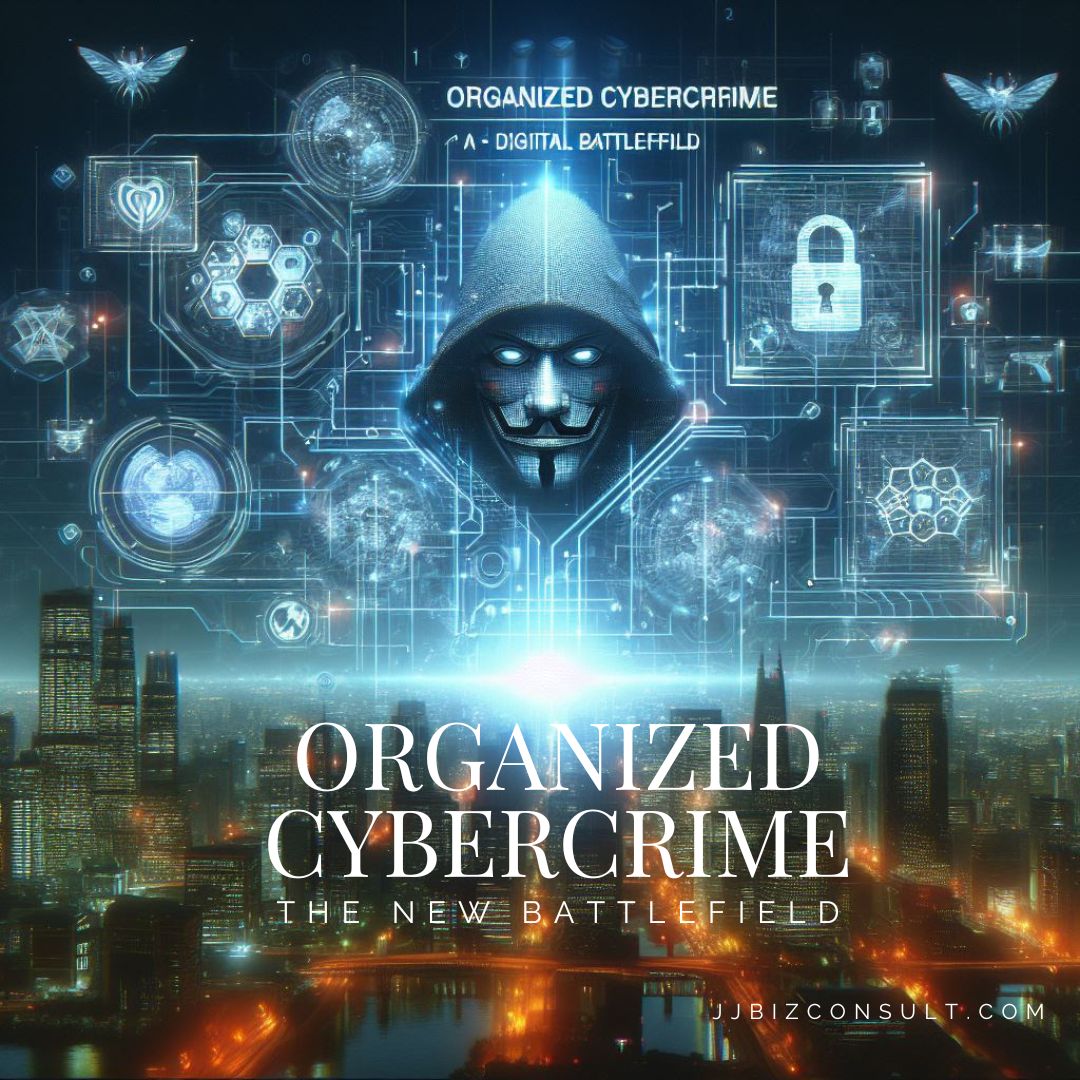Organized Cybercrime: The New Battlefield

Organized Cybercrime.
The Cold War may be over, but the fight for global power has shifted to the digital realm. Organized cybercrime, often backed by nation-states, is a growing threat to critical infrastructure, businesses, and national security.

State-Sponsored Hacking: A Modern Threat
In the past, conflicts played out on physical battlefields. Today, cyberattacks are the new weapons, with organized cybercrime groups acting as digital mercenaries. These groups, often linked to governments, target critical infrastructure, steal intellectual property, and disrupt essential services.
A recent Reuters report highlights this growing concern. The US and UK sanctioned the hacking group APT31, accusing them of a “decade-plus spying spree” targeting American companies and dissidents. China, allegedly linked to the group, denies the accusations. Similar allegations are frequently aimed at Russia and North Korea, whose cyber activities are suspected of funding nuclear programs.
Critical Infrastructure Under Siege
The European Repository of Cyber Incidents (EuRepoC) reveals a worrying trend. Critical infrastructure, including energy, telecommunications, and transportation sectors, is the most targeted by politically motivated cyberattacks.
In 2023 alone, EuRepoC recorded over 500 incidents targeting critical infrastructure, followed by attacks on government institutions and businesses. The trend continues in 2024, with EuRepoC already logging 89 critical infrastructure attacks and 82 targeting state institutions.
These attacks can have devastating consequences. Disabling a power station or disrupting a telecommunications network can cripple a nation.
The Rise of the Cybersecurity Market
The growing threat of organized cybercrime has fueled a booming cybersecurity market. Businesses and governments worldwide are investing heavily in protecting their digital assets. Estimates suggest the global cybersecurity market reached a staggering $160-220 billion in 2023, with significant growth projected in the coming years.
The Fight Against Organized Cybercrime
Combating organized cybercrime requires a multi-pronged approach. International cooperation, improved information sharing, and investment in robust cybersecurity defenses are crucial.
By staying informed about the latest threats and implementing effective security measures, businesses and individuals can help mitigate the risks of organized cybercrime.
 You will find more infographics at Statista
You will find more infographics at Statista
Organized Cybercrime: What are some common cyber attack techniques?
Let’s explore some of the most common cyber attack techniques:
- Malware: Malware, short for malicious software, encompasses various subsets:
- Ransomware: In a ransomware attack, adversaries encrypt a victim’s data and demand payment for the decryption key. These attacks often arrive via phishing emails, but unpatched vulnerabilities and misconfigurations are also exploited.
- Fileless Malware: Unlike traditional malware, fileless malware uses native, legitimate tools within a system to execute attacks. Detection is challenging because it doesn’t require installing code on the target system.
- Spyware: This unwanted software secretly collects information about a user’s web activity without their consent.
- Adware: While not inherently malicious, adware watches a user’s online behavior to determine which ads to display, impacting device performance.
- Trojan: Disguised as legitimate software, trojans are installed through social engineering techniques like phishing or bait websites. The infamous Zeus trojan aims to access financial information and build botnets.
- Worms: Self-replicating programs that spread to other computers.
- Denial-of-Service (DoS) Attacks: Designed to overwhelm a system’s resources, rendering it unable to respond to legitimate service requests.
- Phishing: Cybercriminals send deceptive emails or messages, tricking recipients into revealing sensitive information or clicking on malicious links.
- Spoofing: Attackers impersonate legitimate entities (such as websites or email addresses) to deceive users into divulging confidential data.
- Identity-Based Attacks: These target user credentials, exploiting weak passwords, stolen login details, or vulnerabilities in authentication systems.
- Code Injection Attacks: Malicious code is injected into applications, databases, or scripts, potentially compromising the entire system.
- Supply Chain Attacks: Cybercriminals infiltrate trusted vendors or suppliers to compromise software updates or hardware components.
- Insider Threats: Employees or insiders intentionally or inadvertently leak sensitive data or misuse their access privileges.
- DNS Tunneling: Abusing DNS protocols to bypass security measures and exfiltrate data covertly.
- IoT-Based Attacks: Internet of Things (IoT) devices, often lacking robust security, become targets for cybercriminals.
How can I protect my personal devices from malware?
Safeguarding your personal devices from malware is crucial. Here are some effective strategies:
- Keep Your Operating System and Software Up to Date:
- Regularly update your operating system (OS) and all installed software. Patches and updates often include security fixes that protect against known vulnerabilities.
- Install a Reliable Antivirus Software:
- Choose a reputable antivirus solution. It provides in-depth virus scanning, catches threats others might miss, and runs scans invisibly in the background.
- Be Cautious of Email Attachments and Links:
- Avoid opening attachments or clicking on links from unknown or suspicious sources. Phishing emails often carry malware payloads.
- Use Strong and Unique Passwords:
- Create strong passwords for all your accounts. Consider using a password manager to securely store and manage your credentials.
- Enable Two-Factor Authentication (2FA):
- Whenever possible, enable 2FA for your accounts. It adds an extra layer of security by requiring a second form of verification (such as a text message or authentication app).
- Exercise Safe Browsing Habits:
- Be cautious when visiting websites. Stick to reputable sites, avoid clicking on pop-up ads, and steer clear of suspicious downloads.
Remember, proactive measures significantly reduce the risk of malware infections. Regularly scan your devices, stay informed about security best practices, and invest in reliable security software
US-100 coupon bundle–New app user only

Organized Cybercrime: How to secure the Smartphone from Malware?
Securing your smartphone from malware is essential to protect your data and privacy. Here are some effective strategies:
- Choose a Secure Smartphone:
- Opt for smartphones with built-in security features. Some models prioritize privacy and offer enhanced security out of the box.
- Regularly Update Your OS and Apps:
- Keep your operating system (OS) and apps up to date. Updates often include security patches that address vulnerabilities.
- Install Antivirus and Security Apps:
- Use reputable mobile security apps to scan for malware and protect against threats. Look for features like real-time scanning and app monitoring.
- Download Apps Only from Trusted Sources:
- Stick to official app stores (such as the Play Store for Android or the App Store for iOS). Avoid third-party app sources, as they may host malicious apps.
- Be Cautious with App Permissions:
- Review app permissions before installation. Only grant necessary permissions to apps. For example, a flashlight app doesn’t need access to your contacts.
- Enable Device Encryption:
- Encrypt your device’s storage to safeguard your data. Most modern smartphones offer this feature in the settings.
- Use Strong, Unique Passwords or Biometrics:
- Set a strong password or use biometric authentication (such as fingerprint or face recognition) to unlock your phone.
- Avoid Public Wi-Fi for Sensitive Transactions:
- Public Wi-Fi networks can be insecure. Avoid conducting sensitive tasks (like online banking) over public Wi-Fi.
- Turn Off Bluetooth and Wi-Fi When Not in Use:
- Disable Bluetooth and Wi-Fi when not needed to prevent unauthorized access.
- Backup Your Data Regularly:
- Regular backups ensure you won’t lose critical data if your phone is compromised.
- Use a VPN
Remember, proactive measures significantly reduce the risk of malware infections. Stay informed about security best practices and keep your smartphone defenses strong
Flipper Zero Unleashed: Friend or Foe? Revealing the Power and Potential Risks of this Multi-Tool
Dark Web Leak: Millions of AT&T Customers Affected by Data Breach
#organizedcybercrime #cybersecurity #cyberwarfare





